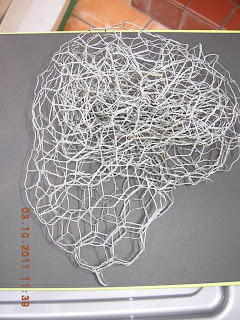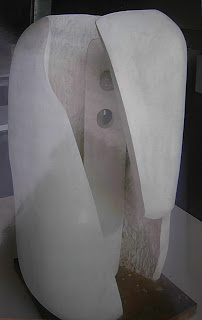I've made small items out of wire before but last October I decided I wanted to try and create a skull out of wire. Pottering in the garden I found a roll of chicken wire behind the shed and decided this would be ideal to use. I also liked the idea of using something for this project that had been used for a different purpose and was now discarded.
The development of this piece was lengthy and time consuming but ultimately very satisfying. Chicken wire is not user friendly and I started off wearing gloves but this was not satisfactory, they were soon discarded and although I ended up with scratches and cuts it was definitely more satisfying feeling the wire with your hands as you worked.
I had initially not intended to make the wire sculpture as dense as this but it was a natural progression and it seemed the right thing to do. I ran out of the discarded chicken wire long before I had finished this sculpture and did need to buy more, but I was very pleased with the result. If you want to see the finished piece go to my website for further pictures.
Monday 30 January 2012
Two faced!
I enjoy experimenting with different materials and last year I decided to try taking face moulds and casting in different materials. I have previously used mod roc when casting body parts(relax only hands and arms......so far) but, felt that results with mod roc varied. So, after researching further I discovered alginate. This is non toxic powder made from seaweed(good) and you mix with water and need to use immediately as it dries literally in minutes (not so good)and within 5-10 mins dries. You need to support the alginate with mod roc because it goes floppy unsupported. You can remove from the part you are casting, once the mod roc dries. As usual hubby volunteered and on the second attempt (the first mix dried immediately) the result was really good.
The alginate picked up the slightest imperfections very easily. I had mixed results with the casting and unfortunately air bubbles in the alginate caused a few problems but overall the moulds were really good. The only disappointment was that I could not use this alginate as a mould for casting resin. Unfortunately there is too much moisture in the alginate and the cast would not be successful. This is a future project to cast a resin head. If you are interested in seeing the results visit my webpage for more pics.
Tuesday 24 January 2012
Is this me?
Setting up this blog has been an experiment for me to see if I would be comfortable sharing thoughts and images of my Gallery visits and artwork. At the moment I find it tedious because I am not fully confident in using this application software, my daughter states I should have put computers in general but I feel that's a bit harsh!
Sunday 15 January 2012
BARBARA HEPWORTH GALLERY WAKEFIELD
I have visited the Gallery twice since the opening last year.
The first time the additional exhibition was Eva Rothschild ‘Hot Touch’. Her work is very minimalistic and the sculptures are positioned in several rooms. I am interested in the materials that she uses. ‘Wandering Palms’ is an assemblage of cast component parts of everyday objects. She also uses in many of her sculptures a substance called Jesmonite, which I was unfamiliar with. Jesmonite is a water based non-toxic moulding material made of gypsum in acrylic resin. She used it effectively, for the ‘donut’ sculpture with ceramic tiles, polystyrene and adhesive.
Barbara Hepworth’s sculptures are exquisite to look at with the different forms, woods and materials she uses. I think this part of the exhibition is well curated. You can actually see film of the casting processes and the tools she would have used. Hepworth said, ‘sculpture is the creation of a real object which relates to our human body and spirit as well as our visual appreciation of form and colour.’
I really like the way she uses plaster on her sculptures. The surface textures are varied and interesting, expressiveness and variety was of great importance to her. She manipulates wet plaster to ‘imbue it with life and feeling’, when it hardened it was carved using a hatchet or axe. She opened up her sculptural forms by piercing through materials to create a hole, creating a relationship and play between inside and outside of the form. This draws the viewers eye in and through the work rather than simply around it.
The second exhibition was the Clare Woods Unquiet Head exhibition. The huge canvasses drawing on her interest in rock formation consisted of layers of enamel on aluminium which were visually ambiguous in detail, a combination of abstraction and figuration. These have a strong physical presence, and you need to view them from several different angles to engage with the images. and figuration. I preferred the smaller abstract paintings of three heads again using enamel and oil on aluminium. The colours worked well on each painting and the three paintings were interesting to view together.
However, on both occasions I felt that Hepworths work was the highlight of the Gallery.
JAUME PLENSA
EXHIBITION YORKSHIRE SCULPTURE PARK
This is the first time an exhibition in this country has brought together his indoor and outdoor work in such an integrated way.
I first became familiar with his work in 2008 with the exhibit of ‘House of Knowledge’ at the Beyond Limits Exhibition at Chatsworth House, Derbyshire.
His mainly figurative work I have found inspirational using different materials steel, glass, bronze and with light or sound and the use of text. This exhibition did not disappoint on any level.
He describes art as, a consequence of life, which possesses enormous capacity to touch people deeply. Poetry and text provide him with inspiration and reference in his own work.
You are able to interact with some of his works, and at YSP, you were able to walk inside the ‘House of Knowledge’ sculpture, which is comprised of letters and experience the sculpture from within becoming the soul of the piece.
 The two heads ‘Nuria and Irma’ are huge stainless steel sculptures ,which dominate the landscape. They appear to be in conversation with each other and although they are large sculptural pieces there is a delicacy about them.
The two heads ‘Nuria and Irma’ are huge stainless steel sculptures ,which dominate the landscape. They appear to be in conversation with each other and although they are large sculptural pieces there is a delicacy about them. The ‘Heart of Trees’ which show a group of 7 human bodies covered in the names of composers who are significant to Plensa hugging and giving life and growth to the trees they are embracing.
The ‘Heart of Trees’ which show a group of 7 human bodies covered in the names of composers who are significant to Plensa hugging and giving life and growth to the trees they are embracing. My favourite piece is ‘See no evil, hear no evil, speak no evil’, exhibited in one of the rooms of the Underground Gallery. Three figures have emotional text inscribed on their faces, openly revealing their inner feelings. These illuminated figures are suspended from the gallery walls in the darkened room displaying the fact that even in our darkest times inner light can suggest future hope.
My favourite piece is ‘See no evil, hear no evil, speak no evil’, exhibited in one of the rooms of the Underground Gallery. Three figures have emotional text inscribed on their faces, openly revealing their inner feelings. These illuminated figures are suspended from the gallery walls in the darkened room displaying the fact that even in our darkest times inner light can suggest future hope.THE BALTIC – GATESHEAD
This was my first visit to the Baltic. The four artists involved all produced very different work.
George Shaw – His paintings are of an area of Coventry where he grew up on a council estate. He uses Humbrol enamel paints for his works. He documents wastelands, deserted houses and garages all give a feeling of melancholy. He concentrates on abandoned areas all very stark.
Martin Boyce – sculptural installation breaking down nature into geometric shapes. He brings the outside in. He is interested in transient spaces belonging to memory. I liked the geometric leaves in the corner of the room, suggests movement as though the leaves are blown into that position.
Hilary Lloyd – video work, the stands, screens, flex and wires are all part of her work. The projectors are placed at head height and are intrusive into the work. It is visual without narrative, using a camera the way someone would use a pencil. Projected images, which are non-specific montages gives an abstract painting effect. The sites mainly appear to be urban landscapes. She doesn’t edit or document the subjects.
A good use of space. I like the idea that the display in front of a large picture window takes on a different feel at night time with the dark backdrop and the city lights.
Karla Black – site specific work. Shows the pre language joy of playing with materials using ephemeral household items such as paper, talc, cling film, bathbombs. There is a fragility about her work, it is rich in texture and very tactile. This is the first work of Karla Blacks I have found interesting. I like the fact you could walk through the piece, touch and view from different angles.
Winner – Martin Boyce
Subscribe to:
Posts (Atom)













